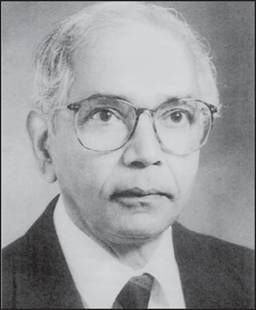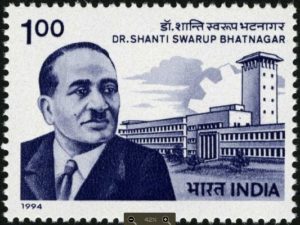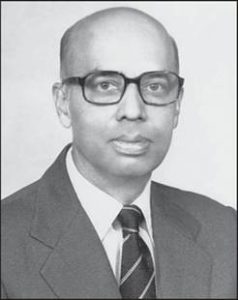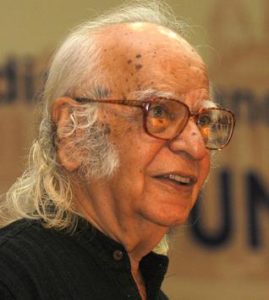Birbal Sahni (1891-1949)
Birbal Sahni the founder of palaeobotanical research in India was a dreamer and a great visionary. He was born on 14th November 1891 at Behra, a small town in Shahpur District (now a part of west Punjab in Pakistan). He was third child of his parents, Mr. Ruchi Ram Sahni and Mrs. Ishar Devi. Ruchi Ram Sahni was an enthusiastic educationist, a great patriot and a devoted social worker. He was a man of independent thinking and progressive ideas. He was a professor of Chemistry at Government College in Lahore. Mrs. Ishwar Devi was a religious lady and was devoted to her family.
_Student.jpg)
Birbal received his early education at Lahore, first at the Mission and Central Model schools and later at the Government College. He was a brilliant student and achieved many academic distinctions during his student life e.g. standing first in Sanskrit in Matriculation, attaining a province position in intermediate Science. After, completing graduation in 1911 from Punjab University (now in Pakistan), he went to Cambridge University for higher studies. He obtained his B.Sc. degree from London University and started his research under inspiring teacher Sir Albert Charles Seward whom he regarded as mentor. In 1913 he obtained first class in Part I of the Natural Sciences Tripos and completed Part II of the Tripos in 1915. In 1919 he was awarded with the degree of Doctor of Science for his research in the field of palaeobotany by the London University. He revised Lawson’s textbook of botany on the advice of his teacher.
_Researcher.jpg)
Birbal Sahni had great passion for out door life and tracking. Traverses from Pathankot to the Rohtang Pass, Kalka to Chini (Hindustan-Tibet Road) via Kasauli, Subathu Simla, Narkanda, Rampur, Bushahr, Kilba Buranpas (16,800 feet high), Srinagar to the Drass Zozila pass, Srinagar to Amarkantak etc. were greatly cherished by him. It was these tracks through the Himalayas, which gave him expansive horizons, breaking through the bounds of insularity that enabled him to view paleobotanical and geological problems in their widest perspectives.
Returning to India he held faculty positions at Banaras Hindu University, Varanasi and Punjab University, Punjab for a year each. In 1921 he joined Lucknow University as Professor of Botany at the age of 30 where at he later also established the geology Department and was head of both the departments.
In the same year he married to Ms Savitri, the daughter of Mr. Sundar Das Suri She was not only the source of encouragement to him but also his strength in all walks of life. She cherished his dream of establishing an Institute of palaeobotany single handedly after his premature demise. For Prof. Sahni work was worship. As he lay on his death-bed, afflicted with cerebral thrombosis, his last thoughts were not for him or for his family but for the newly founded institute. He expressed his intense feeling to his wife before passing to eternal sleep “nourish the institute”.
He was a teacher of par excellence and had great passion for palaeobotany. He started this subject from a small corner in the Botany Department, Lucknow University and ultimately successeded in establishing a well-recognized International Institute on this subject. His love and devotion for this subject helped him to procure fossil material from many countries. He made comprehensive studies on Indian Conifers. Later, he explored wealth of fossil plants from Rajmahal Hills. He studied Ptilophyllum and other elements and found that stem Bucklandia, leaf Ptilophyllum and flower Williamsonia belong to the same plant. He made reconstruction of Williamsonia sewardiana. He discovered petrified wood of Homoxylon rajmahalense, later, which was named as Sahnioxylon rajmahalense. He also described Glossopteris angustifolia Brongniart, Palmoxylon sundram a petrified wood, Cocoswood and a water fern Azolla intertrappea. This was followed by study of Gondwana plants of Salt Range, Karewa flora from Kashmir. He instituted a new plant group ‘Pentoxyleae’ which attracted worldwide attention. His palaeobotanical studies had given support to continental drift theory. In addition he dated some of the rocks of Salt Range to about 40-60 million years, and searched the Deccan traps in Madhya Pradesh and dated them as 62 million years, concluding they belonged to the Tertiary period.
Besides this, he was greatly interested in Archaeology. He did his studies on Yaudheya Coin Moulds from Khokhra- Kot at Rohtak (1936) and from Sunhet near Ludhiana (1941). He threw light on the studies of coin moulds and published his results on “The Technique of Casting Coins in Ancient India” in masterly monograph, Memoirs of the Numismatic Society of India in 1945. This won him Nelson Wright Medal award. In his research paper he had mentioned that the aims and methods of the palaeobotanist are not essentially different from those of the archaeologist. The aim of both is historical: the interpretation and reconstruction of the past.
Besides his deep interest in science, he was fond of music and could play the sitar and violin. His other hobbies were drawing and clay modeling. Whenever time permitted, he loved playing chess. At school times he was a player of hockey and tennis. He represented India Majlis at Tennis and played against the Oxford Majlis.
_Institute_Founder.jpg)
Sahni received number of awards and prizes for his significant contributions. He was the recipient of the Barclay Medal of Royal Asiatic Society of Bengal in 1936, the Nelson Wright Medal of the Numismatic Society of India in 1945 and the Sir C. R. Reddy National prize in 1947. He was elected fellow of Geological Society of Great Britain. He also served the editorial board of the Botanical Journal Chronica Botanica. He was elected vice president of the 5th and 6th International Botanical Congress in 1930 and 1935 held at Cambridge and Amsterdam respectively. In 1936 he was elected as fellow of Royal Society of London. He was general President of the Indian Science Congress in 1940. He was a founder fellow of the National Institute of Science Academy (now Indian Science Academy, New Delhi). The University of Cambridge had recognized his researches and awarded a Sc. D. in 1929, American Academy of arts and Science elected him as its foreign honorary member in 1948. However, in 1950 destiny prevented him to preside as honorary president in International Botanical Congress, held at Stockhlom.
_3.jpg)
Birbal’s foremost ambition was to put palaeobotanical research in India in an organized basis. Initially he established a museum of plant fossils in 1929. In 1939 he constituted the committee of Indian Palaeobotanists named as “The Palaeobotanical Society” and convened a meeting to coordinate and develop research fields in India. The Governing body of Society resolved at 10th September 1946, to establish an Institute of Palaeobotany, which started functioning at the Botany Department, Lucknow University with Professor Sahni as his honorary Director.
The Government of United Provinces gifted a land next to Lucknow University in September 1948. He made comprehensive plan for Institute building and its construction. Pandit Jawahar Lal Nehru, the then Prime Minister of India laid the foundation stone on 3rd April 1949. Sahni in his welcome speech said:
‘the foundation stone symbolizes: A great fact of the antiquity of plant life on the globe, the intellect of man ever trying to bring that fact more and more clearly to light, revealing different stages not only in the evolution of the plant kingdom in more and more orderly and understandable sequence, but also the evolution of his own poor understanding of these truth. The very construction of it, the flaws and imperfections in its entire make up, the labour that has gone into its preparation are all but symbols of our imperfect and helpless efforts at constructing something new, something worthwhile.’
Unfortunately Birbal Sahni passed away a week after the foundation stone laying ceremony was conducted, on 10th April 1949 and could not see his cherished dream “The Institute Grow and Develop”.
To cope with the situation governing body of the Palaeobotanical Society authorized Mrs Savitri Sahni to serve the Institute as Director. Later, in October 1949 the Institute was named after a great scientist, a devoted teacher, a loving husband and affectionate colleague. He is a constant source of inspiration and courage to us.
I would like to end this article by quoting from an obituary written by one of his student Prof. Sadasivan:
“A celebrated botanist has passed away in the wake of national exuberance and I firmly believe that posterity will class Prof. Sahni with Englar, Strasburger, Goebel, DeBerry, of Germany, Guillermond of France, Scott, Seward and Bower of United Kingdom and Brongniart of Prague for his out look like these men of Science was truly.”
Significant research contributions:
Sahni, B. 1922. The present position of Indian Palaeobotany. Presidential address: section of Botany, 8th Indian Science Congress, Calcutta. Proceeding Asiatic Society Bengal New Series 17: 152-175.
Sahni, B. 1923. On the structure of the cuticle in Glossopteris angustifolia Brongniart. Record Geological Survey of India 54: 277-280.
Sahni, B. 1928a. Dicotyledonous plant- remains from Tertiary beds of Assam. Proceedings 15th Indian Science Congress, Bombay: 260-261.
Sahni, B. 1928b. Revision of Indian fossil plants: Part I Coniferales (a. Impression and Incrustations). Memoir Geological Survey of India, Palaeontologia Indica, New Series II: 1-49.
Sahni, B. 1931a. Revision of Indian fossil plants: Part II Coniferales (b. Petrifaction). Memoir Geological Survey of India, Palaeontologia Indica, New Series II: 51-124.
Sahni, B. 1931b. Materials for monographs of the Indian petrified palms. Proceedings Academy of Science U. P. 1: 140-144.
Sahni, B. 1932a. Homoxylon rajmahalense, gen. et sp. nov., a fossil angiospermous wood, devoid of vessels, from the Rajmahal Hills, Bihar. Memoir Geological Survey of India, Palaeontologia Indica, New Series, 20 (2): 1-19.
Sahni, B. 1932b. A petrified Williamsonia(W. sewardiana sp. nov.) from the Rajmahal Hills, India. Memoir Geological Survey of India, Palaeontologia Indica, New Series, 20 (3): 1-19.
Sahni, B. 1932c. Dadoxylon zalessky, a new species of cordaitean trees from the Lower Gondwanas of India. Record Geological Survey of India 66 (4): 414-429.
Sahni, B. 1934. The silicified flora of the Deccan Intertrappean Series- Part II. Gymnospermous and angiospermous fruits. Proceedings 21st Indian Science Congress, Bombay 3: 317-318.
Sahni, B. 1936a. The occurrence of Matonidium and Weicheselia in India. Record Geological Survey of India 71 (2): 151-165.
Sahni, B. 1936b. The Himalayan uplift since the advent of man: Its culthistorical significance. Current Science 5 (1): 57-61.
Sahni, B. 1941. Indian silicified plants-1. Azolla intertrappea Sah and Rao. Proceeding Indian Academy of Science 14B(6): 489-501.
Sahni, B. 1943. Rodites gen. nov. Palaeobotanica Indica 4 (Journal of Indian Botanical Society 22 (1) 17: 180-181.
Sahni, B. 1948.The Pentoxyleae: A group of Jurassic gymnosperms from the Rajmahal Hills of India. Botanical Gazette 110: 47-80.
Sahni, B. 1953. Note on possible Psilophyte remains from Spiti, North-West Himalayas. Palaeobotanist 2: 1-3.
Sahni, B. 1953b. Angiosperm leaf–impression from the Kasauli beds, N. W. Himalayas. Palaeobotanist 2: 85-87.
Contribution by permission of the director of the Birbal Sahni Institute of Palaeobotany, by:
Neeru Prakash
Birbal sahni Institute of Palaeobotany
53 University Road
Lucknow






























.jpg)

_Student.jpg)
_Researcher.jpg)
_Teacher.jpg)
_1.jpg)
_Institute_Founder.jpg)
_3.jpg)
_2.jpg)




